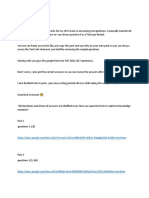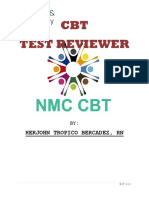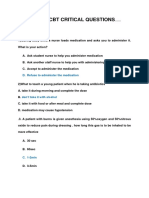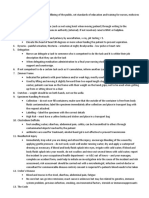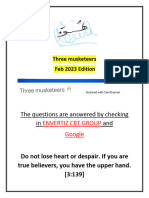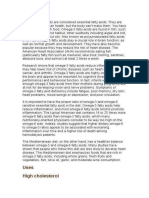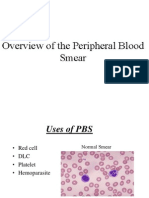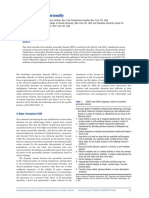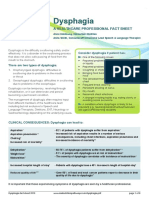CBT Sample Q&A 1 - NMC CBT Sample Questions (Ac)
CBT Sample Q&A 1 - NMC CBT Sample Questions (Ac)
Uploaded by
James Norman OngCopyright:
Available Formats
CBT Sample Q&A 1 - NMC CBT Sample Questions (Ac)
CBT Sample Q&A 1 - NMC CBT Sample Questions (Ac)
Uploaded by
James Norman OngOriginal Title
Copyright
Available Formats
Share this document
Did you find this document useful?
Is this content inappropriate?
Copyright:
Available Formats
CBT Sample Q&A 1 - NMC CBT Sample Questions (Ac)
CBT Sample Q&A 1 - NMC CBT Sample Questions (Ac)
Uploaded by
James Norman OngCopyright:
Available Formats
NMC CBT Sample Questions and CBT Exam Practice 1
Disclaimer: Note that these questions are just sample questions to help you to pass the NMC CBT exam
1. Which is not a cause of postural hypotension?
A. the time of day B. lack of exercise C. temperature D. recent food intake
2. Which is not an expected side effect of lumbar tap?
A. Headache B. Back pain C. Swelling and bruising D. Nausea and vomiting
3. A client was diagnosed to have infection. What is not a sign or symptom of infection?
A. A temperature of more than 38°C C. Chills and sweats
B. warm skin D. Aching muscles
4. What is respiration?
A. the movement of air into and out of the lungs to continually refresh the gases there, commonly called
‘breathing’
B. movement of oxygen from the lungs into the blood, and carbon dioxide from the lungs into the blood,
commonly called ‘gaseous exchange’
C. movement of oxygen from blood to the cells, and of carbon dioxide from the cells to the blood
D. the transport of oxygen from the outside air to the cells within tissues, and the transport of carbon dioxide
in the opposite direction.
5. You noticed that a colleague committed a medication administration error. Which should be done in this
situation?
A. You should provide a written statement and also complete a Trust incident form.
B. You should inform the doctor.
C. You should report this immediately to the nurse in charge.
D. You should inform the patient.
6. A patient on your ward complains that her heart is ‘racing’ and you find that the pulse is too fast to the
manually palpate. What would your actions be?
A. Shout for help and run to collect the crash trolley.
B. patient to calm down and check her most recent set of bloods and fluid balance.
C. A full set of observations: blood pressure, respiratory rate, oxygen saturation and temperature. It is essential
to perform a 12 lead ECG. The patient should then be reviewed by the doctor.
D. Check baseline observations and refer to the cardiology team.
7. You are looking after a postoperative patient and when carrying out their observations, you discover that
they are tachycardic and anxious, with an increased respiratory rate. What could be happening? What would
you do?
A. The patient is showing symptoms of hypovolaemic shock. Investigate source of fluid loss, administer fluid
replacement and get medical support.
B. The patient is demonstrating symptoms of atelectasis. Administer a nebulizer, refer to physiotherapist for
assessment.
C. The patient is demonstrating symptoms of uncontrolled pain. Administer prescribed analgesia, seek
assistance from medical team.
D. The patient is demonstrating symptoms of hyperventilation. Offer reassurance, administer oxygen.
NMC CBT SAMPLE QUESTIONS (AC) 1
8. Why are elderly prone to postural hypotension? Select which does not apply:
A. The baroreflex mechanisms which control heart rate and vascular resistance decline with age.
B. Because of medications and conditions that cause hypovolaemia.
C. Because of less exercise or activities.
D. Because of a number of underlying problems with BP control.
9. When do you see problems or potential problems?
A. Assessment B. Planning C. Implementation D. Evaluation
10. A COPD patient is about to be discharged from the hospital. What is the best health teaching to provide this
patient?
A. Increase fluid intake C. Quit smoking
B. Do not use home oxygen D. nebulize as needed
11. A patient is to be subjected for surgery but the patient’s BMI is low. Where will you refer the patient?
A. Speech and Language Therapist C. Chef
B. Dietitian D. Family member
12. All of the staff nurses on duty noticed that a newly hired staff nurse has been selective of her tasks. All of
them thought that she has a limited knowledge of the procedures. What should the manager do in this
situation?
A. Reprimand the new staff nurse in front of everyone that what she is doing is unacceptable.
B. Call the new nurse and talk to her privately; ask how the manager can be of help to improve her situation.
C. Ignore the incident and just continue with what she was doing.
D. Assign someone to guide the new staff nurse until she is competent in doing her tasks.
13. One busy day on your shift, a manager told you that all washes should be done by 10am. What would you
do?
A. Follow the manager and ensure that everything is done on time.
B. Talk to the manager and tell her that the quality of care will be compromised if washes are rushed.
C. Ignore the manager and just continue with what you are doing.
D. Provide a written statement of the incident.
14. What do you have to consider if you are obtaining a consent from the patient?
A. Understanding B. Capacity C. Intellect D. Patient’s condition
15. A nurse documented on the wrong chart. What should the nurse do?
A. Immediately inform the nurse in charge and tell her to cross it all off.
B. Throw away the page
C. Write line above the writing; put your name, job title, date, and time.
D. Ignore the incident.
16. A patient is in the immediate recovery post-surgery. What should you monitor?
A. Breathing B. Temperature C. Blood loss D. Pain
17. You have a DM patient who is non-insulin dependent. How many portions of fruits and vegetables will you
administer per day?
A. 3 portions B. 4 portions C. 5 portions D. 6 portions
18. A newly qualified nurse is not yet well versed when it comes to documentation. A nurse-in-charge noticed
that this is the case and went to report the new nurse to their manager. What could the newly qualified nurse
NMC CBT SAMPLE QUESTIONS (AC) 2
have done in order to prevent this incident?
A. Ignore the report and just continue with what she was doing.
B. She could have told the manager beforehand in order to have a support and additional training.
C. Apologize that she was not able to inform her immediate head beforehand.
D. Ask for the policies of the hospital in relation to documentation.
19. What ABG readings will you expect among COPD patients?
A. Increased PCO2, decreased PO2 C. Increased PCO2 & PO2
B. Decreased PCO2 & PO2 D. Decreased PCO2, increased PO2
20. A patient was brought to the A&E and manifested several symptoms: loss of intellect and memory; change
in personality; loss of balance and co-ordination; slurred speech; vision problems and blindness; and abnormal
jerking movements. Upon laboratory tests, the patient got tested positive for prions. Which disease is the
patient possibly having?
A. Acute Gastroenteritis C. HIV/AIDS
B. Creutzfeldt-Jakob Disease D. Hepatitis
21. All are risk factors of Coronary Artery Disease except:
A. Obesity B. Smoking C. High Blood Pressure D. Female
22. When would it be beneficial to use a wound care plan?
A. On all chronic wounds C. On all infected wounds
B. On all complex wounds D. On every wound
23. What factors are essential in demonstrating supportive communication to patients?
A. Listening, clarifying the concerns and feelings of the patient using open questions.
B. Listening, clarifying the physical needs of the patient using closed questions.
C. Listening, clarifying the physical needs of the patient using open questions.
D. Listening, reflecting back the patient’s concerns and providing a solution.
24. How do you value dignity & respect in nursing care? Select which does not apply:
A. We value every patient, their families or carers, or staff.
B. We respect their aspirations and commitments in life, and seek to understand their priorities, needs,
abilities and limits.
C. We find time for patients, their families and carers, as well as those we work with. COMPASSION
D. We are honest and open about our point of view and what we can and cannot do.
25. When dealing with a patient who has a biohazard specimen, how will you ensure proper disposal? Select
which does not apply:
A. the specimen must be labelled with a biohazard
B. the specimen must be labelled with danger of infection
C. it must be in a double self-sealing bag
D. it must be transported to the laboratory in a secure box with a fastenable lid
26. For which of the following modes of transmission is good hand hygiene a key preventative measure? A.
Airborne B. Direct Contact C. Droplet D. All of the above
27. What may not be cause of diarrheoa?
A. colitis B. intestinal obstruction C. food allergy D. food poisoning
NMC CBT SAMPLE QUESTIONS (AC) 3
28. What is the most definitive sign/complication 24 hours after liver biopsy?
A. intraperitoneal haemorrhage C. biliary peritonitis
B. infection D. referred pain
29. UK policy for needle prick injury inclues all but one:
A. Encourage the wound to bleed C. Wash the wound using running water and plenty of soap
B. Suck the wound D. Don’t scrub the wound while washing it
30. The following fruits can be eaten by a person with Crohn’s Disease except:
A. Mango B. Papaya C. Strawberries (CAN CAUSE WATERY STOOL INCLUDING RASPBERRIES & TOMATOES) D.
Cantaloupe
31. A patient was recommended to undergo lumbar puncture. As the nurse caring for this patient, what should
you not expect as its complications:
A. Swelling and bruising B. Headache C. Back pain D. Infection
32. Mrs Jones has had a cerebral vascular accident, so her left leg is increased in tone, very stiff and difficult to
position comfortably when she is in bed. What would you do?
A. Give Mrs Jones analgesia and suggest she sleeps in the chair.
B. Try to diminish increased tone by avoiding extra stimulation by ensuring her foot doesn’t come into contact
with the end of the bed; supporting, with a pillow, her left leg in side lying and keeping the knee flexed.
C. Give Mrs Jones diazepam and tilt the bed.
D. Suggest a warm bath before she lies on the bed. Then use pillows to support the stiff limb.
33. A patient is agitated and is unable to settle. She is also finding it difficult to sleep, reporting that she is in
pain. What would you do at this point?
A. Ask her to score her pain, describe its intensity, duration, the site, any relieving measures and what makes it
worse, looking for non-verbal clues, so you can determine the appropriate method of pain management.
B. Give her some sedatives so she goes to sleep.
C. Calculate a pain score, suggest that she takes deep breaths, reposition her pillows, return in 5 minutes to
gain a comparative pain score.
D. Give her any analgesia she is due. If she hasn’t any, contact the doctor to get some prescribed. Also give her
a warm milky drink and reposition her pillows. Document your action.
34. A patient has been confined in bed for months now and has developed pressure ulcers in the buttocks area.
When you checked the waterlow it is at level 20. Which type of bed is best suited for this patient?
A. water mattress B. Egg crater mattress C. air mattresses D. Dynamic mattress
35. What is positive fluid balance?
A. A deficit in fluid volume.
B. A state when fluid intake is greater than output.
C. Retention of both electrolytes and water in proportion to the levels in the extracellular fluid.
D. A state where the body has less water than it needs to function properly.
36. How should you position a patient after lumbar puncture?
A. flat on bed C. semi-fowlers
B. fowlers D. side-lying
37. Why would the intravenous route be used for the administration of medications?
A. It is a useful form of medication for patients who refuse to take tablets because they don’t want to comply
with treatment.
NMC CBT SAMPLE QUESTIONS (AC) 4
B. It is cost effective because there is less waste as patients forget to take oral medication.
C. The intravenous route reduces the risk of infection because the drugs are made in a sterile environment and
kept in aseptic conditions.
D. The intravenous route provides an immediate therapeutic effect and gives better control of the rate of
administration as a more precise dose can be calculated so treatment can be more reliable.
38. A patient has collapsed with an anaphylactic reaction. What symptoms would you expect to see?
A. The patient will have a low blood pressure and will have a fast heart rate usually associated with skin and
mucosal changes.
B. The patient will have a high blood pressure and will have a fast heart rate
C. The patient will quickly find breathing very difficult because of compromise to their airway or circulation.
This is accompanied by skin and mucosal changes.
D. The patient will experience a sense of impending doom, hyperventilate and be itchy all over.
39. When is the time to take the vital signs of the patients? Select which does not apply:
A. At least once every 12 hours, unless specified otherwise by senior staff.
B. When they are admitted or initially assessed.
C. On transfer to a ward setting from critical care or transfer from one ward to another.
D. Every four hours.
40. What are the principles of gaining informed consent prior to planned surgery?
A. Gaining permission for an imminent procedure by providing information in medical terms, ensuring a patient
knows the potential risks and intended benefits.
B. Gaining permission from a patient who is competent to give it, by providing information, both verbally and
with written material, relating to the planned procedure, for them to read on the day of planned surgery.
C. Gaining permission from a patient who is competent to give it, by informing them about the procedure and
highlighting risks if the procedure is not carried out.
D. Gaining permission from a patient who is competent to give it, by providing information in understandable
terms prior to surgery, allowing time for answering questions, and inviting voluntary participation.
41. What do you need to consider when helping a patient with shortness of breath sit out in a chair?
A. They shouldn’t sit out in a chair; lying flat is the only position for someone with shortness of breath so that
there are no negative effects of gravity putting pressure on the lungs.
B. Sitting in a reclining position with the legs elevated to reduce the use of postural muscle oxygen
requirements, increasing lung volumes and optimizing perfusion for the best V/Q ratio. The patient should also
be kept in an environment that is quiet so they don’t expend any unnecessary energy.
C. The patient needs to be able to sit in a forward leaning position supported by pillows. They may also need
access to a nebulizer and humidified oxygen so they must be in a position where this is accessible without
being a risk to others.
D. There are two possible positions, either sitting upright or side lying. Which is used is determined by the age
of the patient. It is also important to remember that they will always need a nebulizer and oxygen and the air
temperature must be below 20° C.
42. If you were told by a nurse at handover to take ‘standard precautions’, what would you expect to be doing?
A. Taking precautions when handling blood and ‘high risk’ body fluids so as not to pass on any infection to the
patient.
B. Wearing gloves, an apron and a mask when caring for someone in protective isolation.
C. Asking relatives to wash their hands when visiting patients in the clinical setting.
NMC CBT SAMPLE QUESTIONS (AC) 5
D. Using appropriate hand hygiene, wearing gloves and an apron when necessary, disposing of used sharp
instruments safely, and providing care in a suitably clean environment to protect yourself and the patients.
43. On checking the stock balance in the controlled drug record book as a newly qualified nurse, you and a
colleague notice a discrepancy. What would you do?
A. Check the cupboard, record book and order book. If the missing drugs aren’t found, contact pharmacy to
resolve the issue. Make sure to fill out an incident form.
B. Document the discrepancy on an incident form and contact the senior pharmacist on duty.
C. Check the cupboard, record book and order book. If the missing drugs aren’t found the police need to be
informed.
D. Check the cupboard, record book and order book and inform the registered nurse or person in charge of the
clinical area. If the missing drugs are not found then inform the most senior nurse on duty. Make sure to fill out
an incident form.
44. The following are signs & symptoms of hypovolemic shock, except:
A. Confusion C. Strong pulse
B. Rapid heart rate D. Decrease Blood Pressure
45. The following must be considered in procuring a consent, except:
A. respect and support people’s rights to accept or decline treatment or care
B. withhold people’s rights to be fully involved in decisions about their care
C. be aware of the legislation regarding mental capacity
D. gain consent before treatment or care starts
46. Which is not an appropriate way to care for patients with Dementia/Alzheimer’s?
A. Ensure people with dementia are excluded from services because of their diagnosis, age, or any learning
disability.
B. Encourage the use of advocacy services and voluntary support.
C. Allow people with dementia to convey information in confidence.
D. Identify and wherever possible accommodate preferences (such as diet, sexuality and religion).
47. All but one, are characteristics of an ideal wound dressing:
A. Cost-effective B. allows gaseous exchange C. Low humidity D. absorbent
48. A 45-year old patient was diagnosed to have Piles (Haemorrhoids). During your health education with the
patient, you informed him of the risk factors of Piles. You would tell him that it is caused by all of the following
except:
A. Straining when passing stool
B. being overweight
C. Lack of fibre in the diet
D. prolonged walking
49. Which behaviours will encourage a patient to talk about their concerns?
A. Giving re assurance and telling them not to worry.
B. Asking the patient about their family and friends.
C. Tell the patient you are interested in what is concerning them and that you are available to listen.
D. Tell the patient you are interested in what is concerning them and if they tell you, they will feel better.
50. What is the difference between denial and collusion?
A. Denial is when a healthcare professional refuses to tell a patient their diagnosis for the protection of the
NMC CBT SAMPLE QUESTIONS (AC) 6
patient whereas collusion is when healthcare professionals and the patient agree on the information to be told
to relatives and friends.
B. Denial is when a patient refuses treatment and collusion is when a patient agrees to it.
C. Denial is a coping mechanism used by an individual with the intention of protecting themselves from painful
or distressing information whereas collusion is the withholding of information from the patient with the
intention of ‘protecting them’.
D. Denial is a normal acceptable response by a patient to a life threatening diagnosis whereas collusion is not.
NMC CBT SAMPLE QUESTIONS (AC) 7
You might also like
- 1060 CBT QuestionsDocument81 pages1060 CBT QuestionsRoxane de Jesus91% (55)
- CBT Sample MCQs - Source Royal Marsden ANSWERSDocument16 pagesCBT Sample MCQs - Source Royal Marsden ANSWERSarchana100% (10)
- CBT Mock TestDocument3 pagesCBT Mock TestLip Stick74% (23)
- Final Guide To Cbt-1Document199 pagesFinal Guide To Cbt-1Anderson Alfred94% (31)
- CBT AND OSCE COMPILED REVIEWERS - JayDocument4 pagesCBT AND OSCE COMPILED REVIEWERS - JayLouie Atnhony Tan100% (3)
- NMC OSCE Professional Values Summary (Version 1)Document4 pagesNMC OSCE Professional Values Summary (Version 1)S. Capanateraiso100% (4)
- CBT 2021 ReviewerDocument63 pagesCBT 2021 ReviewerJasmine100% (9)
- CBT Midwifery Full Mock Test 3 Questions Answers Numerical OrderDocument31 pagesCBT Midwifery Full Mock Test 3 Questions Answers Numerical OrderMimi Boamah100% (3)
- New CBT 2021Document64 pagesNew CBT 2021Shiela Lyn Tachado100% (15)
- Multiple Choice Questions Guide L CBT Exams FOR NMC: 1. What Is The Role of The NMC?Document78 pagesMultiple Choice Questions Guide L CBT Exams FOR NMC: 1. What Is The Role of The NMC?Roxane de Jesus91% (11)
- CBT - Pearsonvue Practice Test 1Document7 pagesCBT - Pearsonvue Practice Test 1AC100% (6)
- New NMC CBTDocument43 pagesNew NMC CBTmary grace carpio100% (9)
- CBT Blissful MaterialDocument223 pagesCBT Blissful MaterialDanial Hassan85% (13)
- CBTDocument238 pagesCBTHarronjardinico Jardinico89% (9)
- CBTDocument20 pagesCBTasharoopsing30% (1)
- NEW CBT 2021 W RationaleDocument82 pagesNEW CBT 2021 W RationaleShini JosephNo ratings yet
- CBT Questions From RM 9th EditionDocument13 pagesCBT Questions From RM 9th EditionXy-Za Roy Marie Albaña100% (6)
- CBT Training ManualDocument15 pagesCBT Training Manualchandrasekharan madhavan100% (2)
- New CBT 2021Document73 pagesNew CBT 2021Live Photos100% (2)
- CBT Exam QuestionDocument68 pagesCBT Exam Questiondianne ignacio100% (1)
- Test of Competence - Part One - Nursing Test BlueprintDocument133 pagesTest of Competence - Part One - Nursing Test BlueprintApril Palantog100% (7)
- Additional Review Material For CBTDocument65 pagesAdditional Review Material For CBTKimAlvarez100% (6)
- Glorious PR FinalDocument188 pagesGlorious PR FinalJulie Silvenia100% (1)
- CBT Practice QuizDocument37 pagesCBT Practice QuizAnderson Alfred71% (14)
- 457 CBT UpdatedDocument82 pages457 CBT UpdatedDass DavidNo ratings yet
- NMC CBT - Sample Exam Practice 2 AnswersDocument7 pagesNMC CBT - Sample Exam Practice 2 AnswersSupremo Manuel M Deluao75% (4)
- CBT Mock 110 AnswersDocument16 pagesCBT Mock 110 Answersjoharinia.sNo ratings yet
- Rationale Answers 1000kplus MCQ CBTDocument305 pagesRationale Answers 1000kplus MCQ CBTarchana86% (7)
- NMC CBT Questions and AnswersDocument2 pagesNMC CBT Questions and AnswersKavalam George100% (2)
- NMC CBT Sample Q&a Part 3 AcDocument14 pagesNMC CBT Sample Q&a Part 3 AcJoane FranciscoNo ratings yet
- NMC CBT Mock Test 1Document15 pagesNMC CBT Mock Test 1Charles Osiako50% (4)
- NMC CBT NumeracyDocument19 pagesNMC CBT NumeracyTitilope50% (2)
- CBT Mock Test Answered - NewDocument10 pagesCBT Mock Test Answered - NewLip Stick100% (20)
- NMC CBT Tips and HacksDocument4 pagesNMC CBT Tips and HacksMike Miraran89% (9)
- NMC CBT Mock Test 2Document13 pagesNMC CBT Mock Test 2Charles Osiako100% (4)
- NMC CBT Mock Test 6Document14 pagesNMC CBT Mock Test 6Charles Osiako100% (2)
- CBT REVIEW MANUAL - Source Royal Marsden Clinical Nursing Procedures - Part 1Document14 pagesCBT REVIEW MANUAL - Source Royal Marsden Clinical Nursing Procedures - Part 1Lip Stick90% (39)
- NMC CBT Mock Test 4Document13 pagesNMC CBT Mock Test 4Charles Osiako50% (2)
- CBT Practice QuizDocument171 pagesCBT Practice QuizCommynile95% (22)
- NMC CBT Mock Test 3.: Question TitleDocument14 pagesNMC CBT Mock Test 3.: Question TitleCharles Osiako50% (2)
- CBTDocument181 pagesCBTAnna May Bacal100% (2)
- Set B CBT 2Document23 pagesSet B CBT 2Anderson Alfred100% (3)
- Review 2018 PDFDocument262 pagesReview 2018 PDF121456990% (10)
- We-Sol CBT Sample MCQsDocument16 pagesWe-Sol CBT Sample MCQsLip Stick100% (6)
- NEW CBT 2021 Summary Q 1Document34 pagesNEW CBT 2021 Summary Q 1himali ranasingheNo ratings yet
- MOCK ABC WITH ANSWER KEY EditedDocument63 pagesMOCK ABC WITH ANSWER KEY Editedchristy I100% (3)
- CBT Questions 1Document23 pagesCBT Questions 1boby100% (3)
- CBT NotesDocument8 pagesCBT NotesNom Nom75% (4)
- 1,000 Questions Questionnaire (Resized Printable)Document91 pages1,000 Questions Questionnaire (Resized Printable)Jerushua Acuna100% (2)
- 1Document60 pages1aman100% (5)
- 1,000+ QUESTIONS WITH ANSWERS (Edited) 5662306635522675875Document252 pages1,000+ QUESTIONS WITH ANSWERS (Edited) 5662306635522675875Uttam Acharya100% (2)
- NMC CBT 2017Document222 pagesNMC CBT 2017Ivee Busta84% (31)
- NMC CBT Blueprint SummaryDocument4 pagesNMC CBT Blueprint SummaryXy-Za Roy Marie Albaña100% (3)
- Three Musketeers Feb 2024Document16 pagesThree Musketeers Feb 2024Paul Andrew VioletaNo ratings yet
- CBT Material SDocument201 pagesCBT Material Slucia0% (2)
- CBT Study GuideDocument10 pagesCBT Study Guideplethoraldork100% (5)
- CBT Study Guide Test of Competence Part 1 - Nursing TestDocument11 pagesCBT Study Guide Test of Competence Part 1 - Nursing TestElvin Arao100% (1)
- CBT Reviewer TipsDocument11 pagesCBT Reviewer TipsMigz Brosas100% (1)
- NMC CBT: Part A-Numeracy (30 Minutes, 15 Questions)Document14 pagesNMC CBT: Part A-Numeracy (30 Minutes, 15 Questions)Amala ElzaNo ratings yet
- Karen Faye's The NotebookDocument65 pagesKaren Faye's The NotebookRandell Senson94% (36)
- Medical Surgical Nursing Exam 5Document27 pagesMedical Surgical Nursing Exam 5St. MatthewGalnayonMa. Alyza KaeNo ratings yet
- Other DisabilitiesDocument42 pagesOther DisabilitiesRica MarquezNo ratings yet
- Case Report: Chronic Obstructive Pulmonary Disorder (Copd)Document10 pagesCase Report: Chronic Obstructive Pulmonary Disorder (Copd)Putri RahmawatiNo ratings yet
- Staphylococcal Scalded Skin Syndrome (SSSS) 1Document7 pagesStaphylococcal Scalded Skin Syndrome (SSSS) 1Abiyoga PramanaNo ratings yet
- Glaucoma and Diabetes - Is There An Association? Jain Shashi, Lakhtakia Sujata, Tirkey Eva Rani, Jain Sheel ChandraDocument5 pagesGlaucoma and Diabetes - Is There An Association? Jain Shashi, Lakhtakia Sujata, Tirkey Eva Rani, Jain Sheel ChandranjmdrNo ratings yet
- Fever - WikipediaDocument9 pagesFever - Wikipediaronan_2905No ratings yet
- Primitive ReflexesDocument10 pagesPrimitive Reflexesbun_yulianaNo ratings yet
- Ventilator Waveform AnalysisDocument76 pagesVentilator Waveform Analysischtbht100% (1)
- New Therapies For Chronic Obstructive Pulmonary Disease: Peter J BarnesDocument12 pagesNew Therapies For Chronic Obstructive Pulmonary Disease: Peter J BarnesZakia DrajatNo ratings yet
- Drug-Induced Hepatotoxicity - Overview, Metabolism of Drugs, Clinical and Pathological Manifestations of Drug-Induced Liver DiseaseDocument20 pagesDrug-Induced Hepatotoxicity - Overview, Metabolism of Drugs, Clinical and Pathological Manifestations of Drug-Induced Liver Diseaseal ghiffari muhammad rayhan100% (1)
- Antimonium TartaricumDocument21 pagesAntimonium TartaricumShah FaisalNo ratings yet
- 1down Syndrome - Nutrition Ppt-1Document15 pages1down Syndrome - Nutrition Ppt-1sheevavillamilNo ratings yet
- Math in MedicineDocument2 pagesMath in Medicinemaluvenki100% (2)
- HYGIENCE and SANITATIONDocument4 pagesHYGIENCE and SANITATIONZefren BotillaNo ratings yet
- Vijaya The Kohinoor of HerbsDocument25 pagesVijaya The Kohinoor of Herbsnitish_vermasNo ratings yet
- Cannabinoids ExplainedDocument9 pagesCannabinoids ExplainedwookmanNo ratings yet
- Learning Objectives PDFDocument6 pagesLearning Objectives PDFSid DhayriNo ratings yet
- OmegaDocument11 pagesOmegaHaninii Suhaila HKNo ratings yet
- PBSDocument72 pagesPBSKavi KaviNo ratings yet
- Healthy FoodsDocument8 pagesHealthy FoodsObed Andalis100% (2)
- Ministry of Transportations Directorate General of Civil AviationsDocument2 pagesMinistry of Transportations Directorate General of Civil Aviationsandri yudiantoNo ratings yet
- Rev 4 - General Gynecology 2022Document28 pagesRev 4 - General Gynecology 2022Omar MohammedNo ratings yet
- Thesis ProposalDocument28 pagesThesis ProposalElla B. CollantesNo ratings yet
- Power PointDocument9 pagesPower PointGabu BuNo ratings yet
- T A D E D - Whole BookDocument208 pagesT A D E D - Whole BookAjay KumarNo ratings yet
- A PDFDocument24 pagesA PDFsshmitaaNo ratings yet
- Borderline (Patient) Personality: A Major Conceptual ShiftDocument5 pagesBorderline (Patient) Personality: A Major Conceptual ShiftASFDNOSAIOksaadnNo ratings yet
- DysphagiaDocument8 pagesDysphagiaDini MarsyaNo ratings yet
- Mmpi Lampiran Manual InggrisDocument75 pagesMmpi Lampiran Manual Inggriskris100% (5)
- Colorectal CancerDocument23 pagesColorectal Cancerralph_gail100% (1)




